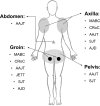Torso hemorrhage: noncompressible? never say never
- PMID: 38448977
- PMCID: PMC10919054
- DOI: 10.1186/s40001-024-01760-4
Torso hemorrhage: noncompressible? never say never
Abstract
Since limb bleeding has been well managed by extremity tourniquets, the management of exsanguinating torso hemorrhage (TH) has become a hot issue both in military and civilian medicine. Conventional hemostatic techniques are ineffective for managing traumatic bleeding of organs and vessels within the torso due to the anatomical features. The designation of noncompressible torso hemorrhage (NCTH) marks a significant step in investigating the injury mechanisms and developing effective methods for bleeding control. Special tourniquets such as abdominal aortic and junctional tourniquet and SAM junctional tourniquet designed for NCTH have been approved by FDA for clinical use. Combat ready clamp and junctional emergency treatment tool also exhibit potential for external NCTH control. In addition, resuscitative endovascular balloon occlusion of the aorta (REBOA) further provides an endovascular solution to alleviate the challenges of NCTH treatment. Notably, NCTH cognitive surveys have revealed that medical staff have deficiencies in understanding relevant concepts and treatment abilities. The stereotypical interpretation of NCTH naming, particularly the term noncompressible, is the root cause of this issue. This review discusses the dynamic relationship between TH and NCTH by tracing the development of external NCTH control techniques. The authors propose to further subdivide the existing NCTH into compressible torso hemorrhage and NCTH' (noncompressible but REBOA controllable) based on whether hemostasis is available via external compression. Finally, due to the irreplaceability of special tourniquets during the prehospital stage, the authors emphasize the importance of a package program to improve the efficacy and safety of external NCTH control. This program includes the promotion of tourniquet redesign and hemostatic strategies, personnel reeducation, and complications prevention.
Keywords: External hemostasis; Noncompressible torso hemorrhage; Prehospital emergency; Trauma.
© 2024. The Author(s).
Conflict of interest statement
The authors declare that they have no competing interests.
Figures





Similar articles
-
Resuscitative Endovascular Balloon Occlusion of Aorta Versus Aortic Cross-Clamping by Thoracotomy for Noncompressible Torso Hemorrhage: A Meta-Analysis.J Surg Res. 2022 Feb;270:252-260. doi: 10.1016/j.jss.2021.09.016. Epub 2021 Oct 26. J Surg Res. 2022. PMID: 34715536 Review.
-
Transition of Resuscitative Endovascular Balloon Occlusion of the Aorta from Zone 3 to Zone 1 to Treat Hemodynamic Collapse during Continued Hemorrhage.Mil Med. 2024 Jan 23;189(1-2):e285-e290. doi: 10.1093/milmed/usad313. Mil Med. 2024. PMID: 37552642
-
Prehospital aortic blood flow control techniques for non-compressible traumatic hemorrhage.Injury. 2021 Jul;52(7):1657-1663. doi: 10.1016/j.injury.2021.02.070. Epub 2021 Feb 26. Injury. 2021. PMID: 33750584 Review.
-
Comparison of zone 3 Resuscitative Endovascular Balloon Occlusion of the Aorta and the Abdominal Aortic and Junctional Tourniquet in a model of junctional hemorrhage in swine.J Surg Res. 2018 Jun;226:31-39. doi: 10.1016/j.jss.2017.12.039. Epub 2018 Feb 10. J Surg Res. 2018. PMID: 29661286
-
Surgical adjuncts to noncompressible torso hemorrhage as tools for patient blood management.Transfusion. 2016 Apr;56 Suppl 2:S203-7. doi: 10.1111/trf.13585. Transfusion. 2016. PMID: 27100757 Review.
References
Publication types
MeSH terms
Grants and funding
LinkOut - more resources
Full Text Sources

